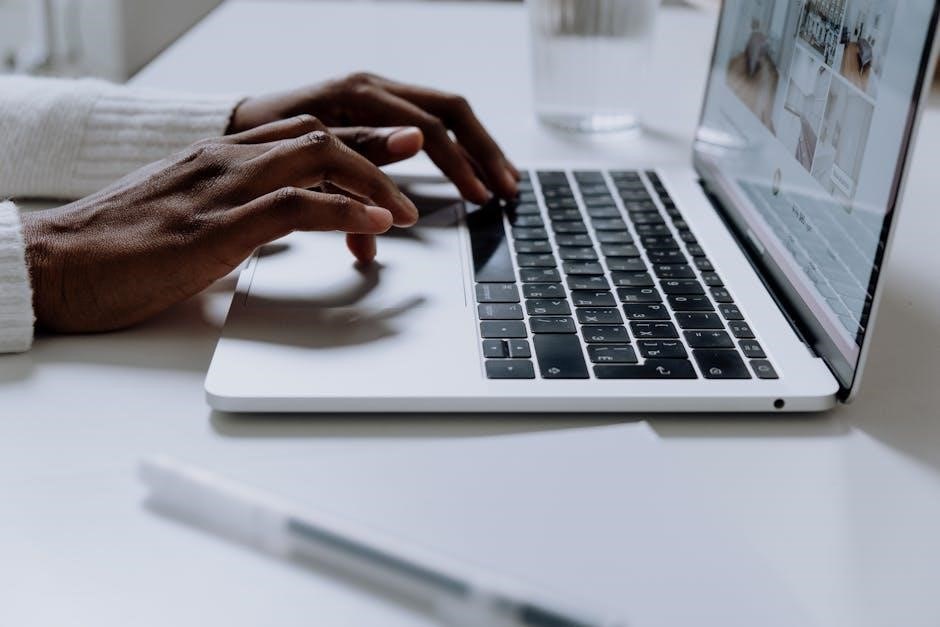Email Etiquette PDF: A Comprehensive Guide
This document provides guidelines for effective email communication, emphasizing concise formatting and descriptive subject lines․ It also discusses the importance of clear communication and the use of professional email addresses for effective interaction․
Email etiquette encompasses a set of social guidelines that govern polite and productive communication․ It’s about behaving effectively, properly, and respectfully when using email․ Like offline etiquette, email etiquette aims to make conversations comfortable and professional․ Mastering email etiquette is essential for building strong relationships in both academic and professional settings․
In today’s digital world, email is a primary communication tool․ Therefore, following proper email etiquette rules is crucial for effective communication․ These rules help ensure that your messages are well-received, understood, and contribute to a positive impression․ This guide aims to provide you with the knowledge needed to navigate the nuances of email communication successfully․
By understanding and applying these principles, you can enhance your professional image and avoid common pitfalls․

Importance of Email Etiquette
Email etiquette is critically important in today’s professional landscape because it directly impacts how you are perceived․ Poor email practices can lead to misunderstandings, damaged reputations, and lost opportunities․ Conversely, mastering email etiquette demonstrates professionalism, respect, and attention to detail․
In a business context, email often serves as the first point of contact with clients, colleagues, and superiors․ A well-crafted email conveys competence and builds trust․ Furthermore, appropriate email etiquette ensures that your message is clear, concise, and easily understood, reducing the likelihood of misinterpretation․
Moreover, adhering to email etiquette guidelines promotes efficient communication, saving time and resources․ Ignoring these guidelines can result in lengthy email chains, unnecessary back-and-forths, and ultimately, a less productive work environment․ By understanding and applying email etiquette, you can foster positive relationships and enhance your overall professional success․
Key Elements of Professional Email Etiquette
Professional email etiquette encompasses several key elements that contribute to effective and respectful communication․ These elements include crafting clear and concise subject lines that accurately reflect the email’s content, using a professional email address that includes your name, and employing appropriate greetings and sign-offs that match the recipient’s level of formality․
Personalizing your messages demonstrates consideration and respect for the recipient, avoiding generic or impersonal language․ Moreover, maintaining a professional tone throughout your email is crucial, avoiding slang, excessive exclamation points, or potentially offensive language․
Furthermore, proofreading your emails meticulously for grammatical errors, typos, and inconsistencies is essential to project credibility․ Paying attention to these key elements ensures that your emails are well-received, your message is understood, and your professional image is enhanced․
Additionally, being mindful of the recipient’s time and needs by keeping your emails focused and to the point is greatly appreciated․
Clear and Concise Subject Lines
Crafting clear and concise subject lines is paramount in professional email etiquette․ A well-written subject line serves as a preview, informing the recipient of the email’s content and purpose․ It should accurately reflect the message’s topic, enabling recipients to prioritize and manage their inbox effectively․ Avoid vague or ambiguous subject lines like “Important” or “Urgent,” as these lack specific information and can be easily overlooked․
Instead, use concise phrases that capture the essence of the email, such as “Meeting Request: Project X Discussion” or “Inquiry Regarding Marketing Campaign․” Including relevant keywords helps recipients quickly identify and locate the email when searching their inbox later․ A clear and informative subject line demonstrates respect for the recipient’s time and ensures that your email receives the attention it deserves․
Consider updating the subject line if the email thread evolves to reflect the current topic of conversation․
Professional Email Address

Using a professional email address is a fundamental aspect of email etiquette, especially in business and academic settings․ Your email address is often the first impression you make, so it’s crucial to ensure it reflects professionalism and credibility․ Avoid using informal or humorous email addresses, as they can undermine your message and damage your reputation․
Ideally, your email address should include your first name and last name, or a variation thereof, to clearly identify yourself to the recipient․ For example, “john․doe@email․com” or “jane_smith@company․com” are suitable options․ If your name is common, you may need to add a middle initial or a number to create a unique address․
When choosing an email provider, opt for a reputable service like Gmail, Outlook, or a domain associated with your company or organization․ These providers offer reliable service and enhance the overall professional image of your email communication․
Appropriate Greetings and Sign-offs
The greeting and sign-off in an email set the tone for the entire message and demonstrate your level of respect and formality towards the recipient․ Choosing the right greeting depends on your relationship with the person you’re addressing․ For formal communications, such as emails to superiors or clients, use “Dear Mr․/Ms․/Dr․ [Last Name]”․ If you have a more casual relationship, “Hi [First Name]” or “Hello [First Name]” may be appropriate․ Avoid overly casual greetings like “Hey” in professional contexts․
Similarly, your sign-off should match the tone of your greeting․ Common professional sign-offs include “Sincerely,” “Best regards,” and “Respectfully․” For more informal emails, “Best,” “Thanks,” or even just your name can be sufficient․ Avoid using overly familiar or cutesy sign-offs in business communications․
Always ensure that your greeting and sign-off are consistent with the overall tone and purpose of your email․ A well-chosen greeting and sign-off can leave a positive impression and contribute to effective communication․
Personalized Messages
While email is often used for quick and efficient communication, it’s important to remember that it’s still a form of personal interaction․ Taking the time to personalize your messages can make a significant difference in how your emails are received․ Start by addressing the recipient by name, using the appropriate level of formality based on your relationship․
Referencing previous conversations or specific details about the recipient’s work or interests can also show that you’ve taken the time to consider them as an individual․ Avoid generic greetings and messages that could be sent to anyone․ Tailor your message to the specific recipient and the purpose of your communication․

A personalized message demonstrates that you value the recipient’s time and input, and it can help to build stronger relationships․ Even a small personal touch can make your emails more engaging and effective․ Remember, a personalized message is more likely to be read and acted upon․
Essential Email Etiquette Rules
Navigating the world of email requires adherence to certain etiquette rules․ These rules ensure clear communication and professional interactions․ One crucial rule is using a direct subject line․ This allows the recipient to understand the email’s purpose immediately․ Another essential rule involves using a professional email address․
Your email address should reflect your name, avoiding unprofessional nicknames․ The “reply-all” button should be used sparingly, only when everyone on the email chain needs to see your response․ Adding a professional email signature is also vital․ This signature should include your name, title, and contact information․
Using professional greetings, such as “Dear [Name],” sets a respectful tone․ Promptly responding to emails is another key rule․ Aim to respond within 24 hours, even if it’s just to acknowledge receipt․ Following these rules helps maintain professionalism and builds a positive impression․ Remember, adhering to email etiquette reflects positively on your communication skills․
Use of Reply-All Button
The “Reply All” button is a powerful tool in email communication, but it should be wielded with caution and consideration․ Overusing this function can lead to cluttered inboxes and unnecessary notifications for recipients who don’t need to be included in the conversation․ It is crucial to assess whether your response is relevant to everyone on the email chain before clicking “Reply All”․
Consider whether your message provides value to all recipients or if it only pertains to a specific individual or subset of individuals․ If your response is only relevant to a few people, it is more appropriate to reply directly to those individuals, excluding the rest of the group․ This practice respects the time and attention of your colleagues․
Using “Reply All” judiciously demonstrates professionalism and consideration for others’ inboxes․ Always pause and think before hitting that button․ Ensure your message is relevant and necessary for every recipient on the email chain to maintain efficient and respectful communication․
Professional Email Signatures
A professional email signature is more than just contact information; it’s a digital business card that reinforces your brand and provides recipients with essential details․ It should include your full name, job title, and the name of your organization․ Adding a phone number and website link can also be beneficial, making it easier for people to contact you․
Keep your signature concise and avoid cluttering it with unnecessary information like inspirational quotes or personal disclaimers․ Use a professional font and color scheme that aligns with your company’s branding․ A well-designed signature enhances your credibility and provides a positive impression․
Ensure your signature is automatically included in every email you send․ This saves time and ensures consistency across all communications․ Regularly review and update your signature to reflect any changes in your contact information or job title․ A thoughtful and professional email signature is a key element of effective email etiquette․

Prompt Response Times
Responding to emails promptly is a crucial aspect of email etiquette, demonstrating respect for the sender’s time and fostering efficient communication․ Ideally, aim to respond within 24 hours, especially for urgent matters or inquiries that require a quick acknowledgment․ If a detailed response requires more time, send a brief reply to let the sender know you’ve received their email and will provide a more comprehensive answer soon․
Ignoring emails or consistently delaying responses can create a negative impression and damage professional relationships․ Prioritize your inbox and allocate time each day to address incoming messages․ Use features like email filters and folders to manage your inbox effectively and ensure important emails don’t get overlooked․
Set realistic expectations for response times, especially if you receive a high volume of emails․ Communicate your availability clearly and let senders know when they can expect a reply․ Prompt and courteous responses contribute to a positive and productive communication environment․
Common Email Etiquette Mistakes to Avoid
Navigating the world of email communication requires awareness of common pitfalls that can undermine professionalism and damage relationships․ One prevalent mistake is crafting lengthy, rambling messages that lack focus and clarity․ Avoid overwhelming recipients with excessive information; instead, strive for concise and direct communication․
Another frequent misstep involves the overuse of jargon and acronyms, which can confuse recipients unfamiliar with specialized terminology․ Opt for plain language that is easily understood by a broad audience․ Maintaining a professional tone is equally essential; avoid sarcasm, humor, or overly casual language that could be misinterpreted․
Neglecting to proofread emails before sending is a common error that can erode credibility․ Typos, grammatical errors, and punctuation mistakes detract from the message and convey a lack of attention to detail․ Always take a moment to review your email carefully before clicking send․
Long, Rambling Messages
One of the most common email etiquette mistakes is sending long, rambling messages․ These emails often lack a clear focus and can be overwhelming for the recipient to read and understand․ A recipient may struggle to discern the main point or action required, leading to frustration and inefficiency․
To avoid this pitfall, it is crucial to keep your emails concise and to the point․ Before writing, take a moment to outline the key message you want to convey․ Structure your email logically, using paragraphs to separate different ideas․ Use bullet points or numbered lists to present information in a clear and organized manner․
Remember, brevity is key․ Respect the recipient’s time by getting straight to the point and avoiding unnecessary details or tangents․ By crafting concise and focused emails, you ensure that your message is easily understood and acted upon promptly․
Excessive Jargon or Acronyms
Using excessive jargon or acronyms in emails is a common etiquette mistake that can hinder effective communication․ While industry-specific terms may be familiar to some, they can be confusing or alienating to others, especially those outside your immediate field or organization․
To ensure clarity, avoid using jargon or acronyms unless you are certain that the recipient understands them․ If you must use them, provide a brief explanation or definition the first time they appear in the email․ This helps to prevent misunderstandings and ensures that your message is accessible to a wider audience․
Consider your audience and tailor your language accordingly․ Opt for clear, simple language that is easy to understand, regardless of the recipient’s background or expertise․ By avoiding excessive jargon and acronyms, you promote clear and effective communication, fostering positive professional relationships․
Unprofessional Tone
Maintaining a professional tone in emails is crucial for conveying respect and credibility․ Avoid using overly casual language, slang, or humor, as these can be easily misinterpreted and may damage your professional image․ Even in internal communications, a degree of formality is generally expected․
Refrain from using sarcasm, which can be particularly problematic in written communication, as the recipient may not detect the intended tone․ Similarly, avoid expressing anger, frustration, or other negative emotions in your emails․ If you need to address a sensitive issue, do so calmly and diplomatically, focusing on facts rather than personal feelings․
Always proofread your emails carefully to ensure that your tone is appropriate and respectful․ Consider how your message might be perceived by the recipient and adjust your language accordingly․ A professional tone demonstrates courtesy, professionalism, and a commitment to effective communication․
Neglecting Proofreading
Failing to proofread emails before sending them is a significant error that can undermine your credibility․ Grammatical errors, typos, and misspellings can make you appear careless and unprofessional․ Always take the time to review your message carefully to ensure clarity and accuracy․
Pay close attention to sentence structure, punctuation, and word choice․ Consider using a grammar and spell checker to identify potential errors, but don’t rely on these tools exclusively․ Read your email aloud to catch mistakes that might be missed when reading silently․
Proofreading is especially important for formal communications, such as job applications, business proposals, or emails to senior management․ Even in informal exchanges, taking the time to proofread demonstrates respect for the recipient and ensures that your message is understood as intended․ A well-proofread email reflects attention to detail and commitment to quality․
